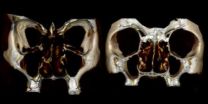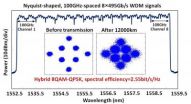(Press-News.org) ANN ARBOR— Cryptic comments seem to have an ambiguous, obscure or hidden meaning. In biology, cryptic species are outwardly indistinguishable groups whose differences are hidden inside their genes.
Two University of Michigan marine biologists have identified three cryptic species of tiny clams, long believed to be members of the same species, which have been hiding in plain view along the rocky shores of southern Australia for millions of years.
The unusual convergence of a climate-cooling event and the peculiarities of local geography caused the three cryptic species to split from a common ancestor more than 10 million years ago, the U-M researchers propose in a paper to be published next month in the journal Molecular Ecology.
The U-M scientists conducted a genetic analysis after collecting thousands of the crevice-dwelling, rice grain-sized clams from hundreds of miles of southern Australia coastline over the past decade. Their findings provide insights about the forces that shape evolution and solve a puzzle that has stumped marine biologists for decades.
"This study provides important clues about how marine regional biotas can evolve, including our observation that these processes can involve major global climate change modulated by local geography," Jingchun Li, lead author of the report and a doctoral student in the U-M Department of Ecology and Evolutionary Biology.
Li conducted the research as part of her dissertation with co-author Diarmaid O'Foighil, Li's adviser and director of the U-M Museum of Zoology.
"You cannot tell them apart physically, but their genes indicate that their evolutionary divergence predates that of humans from chimpanzees," O'Foighil said of the three clam groups, which are currently classified as members of the same species, Lasaea australis.
Australia's southern coastline is home to three evolutionarily distinct assemblages of marine species known as biogeographic provinces. Each province contains hundreds of species of invertebrates, fish, algae and other organisms, and there are substantial differences between the species living in each province.
Here's the riddle that has perplexed biologists for decades: How did these three distinct biogeographic provinces evolve along a continuous coastline? The emergence of new species often begins when gene flow between populations is reduced or eliminated. This type of genetic isolation happened routinely throughout evolutionary history when populations became physically separated — when a new physical barrier such as a mountain or a river split the geographic range of a species, for example.
But what force could drive speciation along an unbroken coastline with no obvious barriers to gene flow?
The genetic analysis by Li and O'Foighil, which is backed by evidence from the fossil record, shows that the three cryptic clam species began splitting away from a common ancestor 13 or 14 million years ago.
That's about the same time that a major climate-cooling event called the middle Miocene climate transition permanently lowered sea-surface temperatures in the southwest Pacific Ocean — including the southern coast of Australia — by 10.8 to 12.6 degrees Fahrenheit.
Li and O'Foighil propose that the cooling event partitioned Australia's southern coastline into three zones with a cool region, including the present-day southeastern state of Victoria and the island of Tasmania, flanked on either side by two relatively warm ones.
The emergence of three temperature zones created opportunities for local adaptation that isolated the organisms living within each zone. That isolation led, in turn, to the evolution of the three biogeographic provinces seen today, according to Li and O'Foighil.
In their study, Li and O'Foighil showed that each of the three cryptic clam species is found in only one of the three biogeographic provinces.
"I know of no other case where you start out with one marine biota, then a climate-change event results in the generation of three biotas from that one," O'Foighil said. "A key finding of the study is that relatively ancient climate-change events can shape marine biotas."
###
The third author of the Molecular Ecology paper is Joong-Ki Park of Chungbuk National University in South Korea. The study was supported by a Malacological Society of Australia Molluscan Research Grant and a U-M Rackham International Research Award to Li and a National Science Foundation grant to O'Foighil.
More about O'Foighil: http://www.lsa.umich.edu/eeb/directory/faculty/diarmaid/
More about Li: http://www.lsa.umich.edu/eeb/directory/graduates/jingchun/default.asp END
HeLa cells are the world's most commonly used human cell lines, and have served as a standard for understanding many fundamental biological processes. In a study published today in G3: Genes, Genomes and Genetics online, scientists at the European Molecular Biology Laboratory in Heidelberg, announce they have successfully sequenced the genome of a HeLa cell line. It provides a high-resolution genomic reference that reveals the striking differences between the HeLa genome and that of normal human cells. The study could improve the way HeLa cells are used to model human biology.
The ...
Once Andrei Tokmakoff gets his new laser laboratory operational later this year, he will use the world's shortest infrared light pulses to pluck molecular bonds like a stringed musical instrument.
Tokmakoff, the Henry G. Gale Distinguished Service Professor of Chemistry, arrived at the University of Chicago in January to tackle new problems in biology with the aid of ultrafast vibrational spectroscopy methods that he has developed.
"He does very sophisticated spectroscopy, in particular vibrational spectroscopy," said Richard Jordan, professor and chairman of chemistry. ...
Researchers from Sahlgrenska Academy, University of Gothenburg, Sweden, have found that a commonly used drug to treat anemia in heart failure patients does not improve patients' health, nor does it reduce their risk of death from heart failure. Results of the international study were presented at the American College of Cardiology's annual meeting in San Francisco on March 10 and published simultaneously online by The New England Journal of Medicine.
Initiated in 2006, the RED-HF (Reduction of Events With Darbepoetin Alfa in Heart Failure) trial involved 2,278 anemic ...
Des Moines, IA – A new study by researchers at the University of Arizona and Northwest Missouri State University shows that standing and lying behavior can predict heat stress in cows.
In a presentation at the 2013 ADSA Midwest Branch / ASAS Midwestern Section Meeting, Dr. Jamison Allen explained that predicting heat stress is vital for keeping cows healthy and productive. Cows will pant, eat less and produce less milk when their core body temperature increases.
Allen said cows prefer standing to lying on hot days. Cows stand to allow more of their surface area to disperse ...
Philadelphia, Pa. (March 12, 2013) – Ten years after stroke caused by a ruptured aneurysm of the brain, surviving patients have persistent difficulties in several areas affecting quality of life, reports a study in the March issue of Neurosurgery, official journal of the Congress of Neurological Surgeons. The journal is published by Lippincott Williams & Wilkins, a part of Wolters Kluwer Health.
The long-term impact of ruptured aneurysms causing subarachnoid hemorrhage (SAH) highlights the need for "survivorship care plans" comparable to those made for long-term cancer ...
Pity the poor maxillary sinuses. Those bulbous pouches on either side of the human nose are known more for trapping mucus and causing sinus infections than anything else. They were thought to be an evolutionary relic of our distant past, with little known present value.
Yet researchers led by the University of Iowa believe the unheralded maxillary sinuses play a fortuitous, integral role in the shape and function of the human nose, even today. After studying faces of African and European origin, the team has concluded that the maxillary sinuses act as a cushion of sorts, ...
Philadelphia, PA, March 12, 2013 – Cognitive impairments are disabling for individuals with schizophrenia, and no satisfactory treatments currently exist. These impairments affect a wide range of cognition, including memory, attention, verbal and motor skills, and IQ. They appear in the earliest stages of the disease and disrupt or even prevent normal day-to-day functioning.
Scientists are exploring a variety of strategies to reduce these impairments including "exercising the brain" with specially designed computer games and medications that might improve the function ...
Antibiotic-resistant Escherichia coli (E. coli) continues to proliferate, driven largely by expansion of a strain of E. coli know as sequence type ST131. A new study points to hospitals and long-term care facilities (LTCF) as settings in which this antibiotic-resistant strain is increasingly found. The study is published in the April issue of Infection Control and Hospital Epidemiology, the journal of the Society for Healthcare Epidemiology of America.
E. coli is the most common gram-negative pathogen, causing both gastrointestinal disease and extraintestinal infections ...
Infants as young as nine months old prefer individuals who punish those who are not like them, and this seemingly innate mean streak grows stronger in the next five months of life, a study by researchers at Yale University has found.
Babies, like adults, prefer individuals who like the same things they do. A new study reports that they want individuals who share their tastes to be treated well by others, but want those whose tastes differ from their own to be treated badly. The study of 200 nine- and 14-month-old infants was published online in Psychological Science, ...
As network carriers debate the next Ethernet standard—and whether transmission speeds of 400 gigabit per second or 1 terabit per second should be the norm—engineers are working on new measures to squeeze next-generation performance out of current-generation systems.
To that end, a team from AT&T has devised a new patent pending technique enabling tuning of the modulation spectral efficiency, which allows, for the first time, 400 Gb/s signals to be sent over today's 100 gigahertz-grid optical networks over ultra-long distances. Spectral efficiency is the information rate ...


